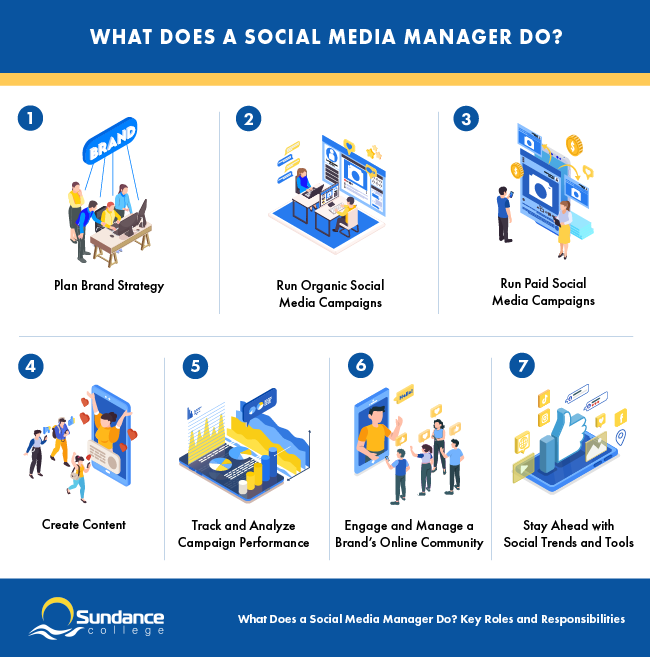Blog / What Does a Social Media Manager Do? Key Roles and Responsibilities
What Does a Social Media Manager Do? Key Roles and Responsibilities

Digital Marketing and Social Media Management Diploma
- Digital Marketing Assistant/Coordinator
- Advertising Account Executive
- Marketing Assistant/Coordinator
- Content Marketer
Table of Contents
A social media manager creates and maintains a brand’s online presence by turning ideas into engaging content. They plan campaigns, organize schedules, interact with followers, and analyze performance to improve strategies.
Their role also involves tracking trends, managing communities, and building strong audience relationships. Before diving into their daily tasks, let’s first understand what a social media manager is and why their role matters.
Listen to: “What Does a Social Media Manager Do? Key Roles and Responsibilities”
What is a Social Media Manager?
A social media manager is a professional who oversees a brand’s activities on social platforms. They act as the brand’s voice online, building its presence, engaging with audiences, and maintaining its identity across various channels.
They may work in-house for a single company, focusing exclusively on its social media needs, or for agencies where they manage accounts for multiple clients. In smaller businesses, they often balance planning strategies with hands-on tasks like content creation and campaign execution.
But what does this role really involve on a day-to-day basis? Let’s break it down.
Duties and Responsibilities of a Social Media Manager
A social media manager does more than just post pretty pictures or write clever captions. They manage every aspect of a brand’s social media to achieve its goals, whether by working with a team or handling tasks independently. Their main responsibilities include:
Plan Brand Strategy
Ever notice how brands always post the right content at the right time? That’s the work of social media managers, who carefully plan every move.
Here’s what goes into a winning strategy:
- Brand Identity: Defining who the brand is and what it represents.
- Visual Identity: Creating a consistent look that stands out.
- Target Audiences: Understanding who the brand wants to reach.
- Campaign Goals: Setting clear objectives for each post and campaign.
- Platform Selection: Choosing the right channels for the audience.
- Performance Analytics: Using data to tweak and improve results.
With these elements in place, every post is intentional, every message resonates, and every campaign keeps followers engaged.
Run Organic Campaigns
Social media managers run targeted organic campaigns, creating posts, reels, and stories to achieve goals like boosting engagement or driving sales. These campaigns are time-bound, themed, and built to guide audiences toward a clear objective.
Take Coca-Cola’s Share a Coke campaign, for example:
- Personalized Posts: People shared photos of Coke bottles with their names.
- Influencer Partnerships: Influencers showcased their bottles, creating a buzz.
- Contests and Hashtags: Users posted with #ShareACoke, building community engagement.
With a focus on personalization and fun, this campaign increased sales and connected audiences to the brand during the summer.
Run Paid Social Media Campaigns
Have you noticed how some ads seem to really connect with you on a personal level? It’s no accident! Some social media managers are tasked with planning out social media advertising campaigns that will resonate with their audience and result in sales for their business. To do this, they need to be well-versed in paid ad strategies.
Platforms like Facebook, Instagram, and LinkedIn let businesses and brands target ads based on your location and interests. This means that social media managers can use these tools to deliver their message to you effectively, all within a specific budget.
Create Content
Creating engaging content is the bread and butter of social media managers. They start by analyzing what you like and how you behave online using tools like Social Media Analytics and Google Analytics. With this information, they create detailed calendars mapping out what to post, when to post, and where to post it. Every move is data-driven to ensure maximum impact.
Their content comes in all shapes and sizes—text, images, videos, gifs, infographics, you name it! Each piece is finely tuned to fit the vibe of different social media platforms, ensuring it grabs your attention. For example, they might break down a blog post into a series of snappy tweets or transform a lengthy webinar into fun, bite-sized video clips.
Besides that, social media managers are experts at repurposing content to keep things fresh and appealing, making sure you stay hooked and eager for more. So next time you find yourself captivated by a post, you know who’s behind it!
Track and Analyze Campaign Performance
Once the content is posted and campaigns are live, social media managers actively monitor how well their posts are performing, making sure every campaign hits the mark. They can use social media analytics tools like Hootsuite, Sprout Social, and Buffer to track metrics such as likes, shares, and comments across multiple platforms or use the analytics in the social media platforms themselves.
No matter where they choose to find their data, this real-time feedback helps them pinpoint what works and what needs improvement. For instance, if a particular post gets good engagement, they can use target audience analysis, competitive analysis, and engagement insights to understand the reason behind its success and replicate the winning formula.
Engage and Manage a Brand’s Online Community
Social media managers know how to keep a brand’s online community engaged.
Take Airbnb, for example. Their strategy encourages guests to share travel stories using hashtags like #AirbnbExperiences, showcasing real adventures that inspire other travelers.
On the other hand, Nike fosters tight-knit communities through sub-accounts like Nike Running and Nike Football. These accounts engage users with tailored content, interactive challenges, and user-generated posts.
By interacting with followers, practicing social listening, and sharing authentic, interactive content, social media managers build loyal communities that are proud to connect with the brand.
Stay Ahead with Social Trends and Tools
Social media managers constantly track trends and tools to keep brands in the spotlight.
Think about the Ice Bucket Challenge, where brands raised ALS awareness while showing their playful side, or the Stay at Home Challenge during the pandemic, which brought people together through routines and DIY projects.
Alongside viral challenges, they use trending formats like TikTok and Instagram Reels and tools like Instagram Shopping for seamless online buying. Their toolkit includes:
- Analytics tools (Google Analytics, Sprout Social) to track performance.
- Content creation tools (Canva, Adobe Spark) for standout visuals.
- Scheduling tools (Buffer, Hootsuite) to post consistently.
- Social listening tools (Brandwatch, BuzzSumo) to monitor mentions and trends.
- Influencer marketing tools (AspireIQ, Upfluence) to amplify reach through partnerships.
With these tools and strategies, social media managers boost engagement and keep brands ahead of the competition.

Social Media Manager Job Overview and the Next Steps
Being a social media manager is a role that blends creativity, strategy, and data analysis. It offers opportunities to create content, engage audiences, and drive results for brands.
In this role, you’ll create posts as part of strategic campaigns, build online communities, run campaigns, and monitor trends to keep brands connected with their audience.
To help you build these skills, Sundance College’s Digital Marketing & Social Media Management diploma program offers a comprehensive learning path. You’ll explore areas like social media strategy, content marketing, SEO, PPC, email marketing, and digital analytics.
With guidance from experienced instructors, you’ll develop the expertise to turn ideas into actionable marketing strategies. To learn more about the program, practicums, and financial aid options, contact an admissions advisor today.
Related Blogs
Subscribe for more career advice
Blog Categories
Share on:
